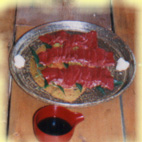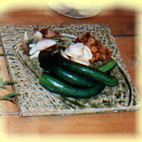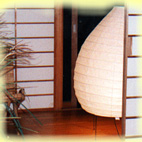




The table is set...


Fresh cucumbers...


Imaizumi Masato and guests...
About a month before leaving Japan [see Letters from Angela, Ed.], I went to a dinner party. It was hosted by Imaizumi Masato, son of Imaizumi Imaemon XIII, the Living National Treasure of Arita porcelain.
The term Ningen Kokuho (Living National Treasure), also known as Juyo Mukei Bunkazai Hojisha (Bearers of Important Intangible Cultural Assets) was first designated by the Japanese government in 1955. After WWII, the Law for the Protection of Cultural Assets was promulgated and a preservation program administered by the Agency of Cultural Affairs of the Ministry of Education continues to designate Living National Treasures. This is in order to preserve and teach skills for the continuation of traditional crafts. Artists designated as Living National Treasures are highly respected with near celebrity like stardom. They are responsible for leaving detailed records of their life's work and are expected to teach their skills to younger artists.
When I met Imaizumi Masato through another ceramicist friend, I was eager to ask what it was like to have a father who was a Living National Treasure. He made is seem as though it wasn't anything special but from his conversations and seeing his personal art work, it was clear that this was a man who was born to a life surrounded by very fine ceramics. Imaizumi Imaemon XIII is renown for his colorful and elaborately decorated porcelain ware but unlike his father, Imaizumi Masato works with a more subtle palette, often without any color. He also makes porcelain slip cast sculptural forms.
The dinner party was held at Masato's house. It was built by his architect friend, whom I sat across from that night. A dinner party in the American sense would most likely be held in a dining room with a big table and chairs. There was indeed a very large table but it hovered low and instead of chairs, we sat on the floor on round woven mats. Furniture was minimal and it was an ideal environment for the Isamu Noguchi akari lamps that softly lit the rooms. One huge akari loomed in a back room and that space looked like it came straight out of a "Japanese Style" book.
Like the furnishings, the food was minimal as well. Not in portion but in its spare preparation. Aside from some cooked pumpkin and prepared grapes as appetizers, most of the food was raw. Juxtaposing the elegant, almost delicate table settings were heaps of raw ginger and whole cucumbers to just grab, break, and gnaw on. There were also chunks of boiled wild potatoes and platters of raw horse meat and cow's tongue. These raw meats were dabbed with some soy sauce or grainy salt and eaten with the raw ginger. It may seem primal but raw horse meat is a delicacy, especially in Southern Japan.
It was indeed a special meal. The array of plates, bowls, and little dishes were themselves like installation art. Thick square oribe-green slabs served as platters and smaller thrown porcelain dishes were our dinner plates. In accord with the season, the plates were decorated with large carved maple leaves. What I absolutely adored were the chopstick rests. True to the region, each person had a small chunk of feldspar to rest their chopsticks on. It was also at this dinner that I learned that porcelain in Japan is not made from kaolin. Instead, the white clay which defines porcelain in Japan is actually made from a mineral called porcelain stone. The director of Arita's Museum of History enlightened me with this information. For years I thought that all porcelain was made from kaolin but I trusted this man's authority.
Throughout the night, we also devoured fresh crabs, fish, a wonderfully flavored miso-based soup and a kind of rice that I never had before. It was black and supposedly the rice that people from the ancient Yayoi era regularly ate. Along with bottles of fine, fine sake, I felt like I was partaking in a lavish and decadent gathering (who said Japan was in the middle of one of its worst recessions?!), but looking back, I also realize that it was one of those moments when food, space, ceramics, and conversation were all perfectly entwined, when the dynamics of art and life coexist naturally.

An Akari lamp...